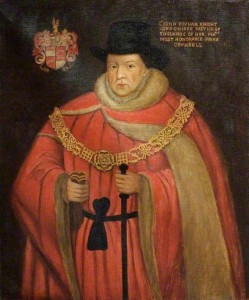Sir John Popham was an owner of the site but it is unlikely that he actually lived on site. He lived from 1531 to the 10th June 1607. He was born in 1531 at Huntworth in North Petherton, near Bridgwater, Somerset. He was the second son of Alexander Popham (c.1504-1556) of Huntworth, and Jane Stradling, the daughter of Sir Edward Stradling of St Donat’s Castle, Glamorgan.
As St Donat’s Castle was on the south coast of Glamorgan and a short sail across the Bristol Channel into the inland port of Bridgwater on the River Parret it must have been like marrying the girl next door. The Popham family had held the manor of Huntworth since the 13th century and it was therefore unlikely that Sir John would want to move to Glamorgan notwithstanding his wife’s Welsh connections.
He was educated at Balliol College, Oxford where he read classics and divinity, and entered the Middle Temple as a law student. Thereafter he served as an MP for Lyme Regis in 1558 and for Bristol in 1571 and 1572 and was a Justice of the Peace in Somerset. He served as Recorder of Bridgwater and of Bristol. He was promoted to serjeant-at-law in 1578 and appointed Solicitor-General in 1579. He rose further and quickly and was Speaker of the House of Commons from 1580 to 1583, Attorney General from 1581 to 1592 and Lord Chief Justice of England from 1592 to 1607. By any standard his career was impressive. His wealth increased substantially as one might imagine for the period. Apart from the site where The Court now stands he owned Publow in Somerset, Littlecote in Wiltshire, and Hemyock Castle in Devon.
He was certainly a colourful character. Whilst Lord Chief Justice he presided over the trial of the Jesuit Robert Southwell in 1595 and passed sentence of death by hanging, drawing and quartering. He also presided over the trials of Sir Walter Raleigh (1603) and the conspirators of the Gunpowder Plot, including Guy Fawkes (1606). He was also involved in the trial at Fotheringay of Mary, Queen of Scots (1587) which resulted in her execution.
It was not all plain sailing for him. While working as the messenger to the Queen, Popham was imprisoned by Robert Devereux. Ever stoic, Popham replied that at his age, death would be “but cutting off a few years.” However, he was rescued and rowed to safety by Sir Ferdinando Gorges.
He was noted for his severity towards thieves and strict enforcement of the Penal Laws. Popham is credited with maintaining the stability of the British State, and for being one of the “real colonisers” of the British Empire as he funded and orchestrated the aborted Popham Colony at the mouth of the Kennebec River, Maine in 1607–1608. He was known for being very keen on extradition of thieves to the proposed colony in an attempt to make this work.
There must have been something in the genes as Sir John married Amy Adams (alias Games), daughter and heiress of Hugh (alias Howel) Adams (alias Games) of Castleton, Glamorgan, a fortified manor house north-east of St Athan. By his marriage Sir John inherited Castleton but soon sold it to his maternal relative Sir Thomas Stradling of St Donat’s Castle.
It was said that Sir John acquired the reversion of the estate of Littlecote from William Darrell MP as a bribe for having obtained a nolle prosequi in favour of the murderer William “Black” Darrell, and following the latter’s death in 1589 became its owner.
Sir John lived until he was 76 years old which, for those days was quite a feat.
